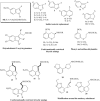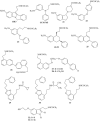Melatonin receptor agonists: new options for insomnia and depression treatment
- PMID: 21554566
- PMCID: PMC6493855
- DOI: 10.1111/j.1755-5949.2010.00197.x
Melatonin receptor agonists: new options for insomnia and depression treatment
Abstract
The circadian nature of melatonin (MLT) secretion, coupled with the localization of MLT receptors to the suprachiasmatic nucleus, has led to numerous studies of the role of MLT in modulation of the sleep-wake cycle and circadian rhythms in humans. Although much more needs to be understood about the various functions exerted by MLT and its mechanisms of action, three therapeutic agents (ramelteon, prolonged-release MLT, and agomelatine) are already in use, and MLT receptor agonists are now appearing as new promising treatment options for sleep and circadian-rhythm related disorders. In this review, emphasis has been placed on medicinal chemistry strategies leading to MLT receptor agonists, and on the evidence supporting therapeutic efficacy of compounds undergoing clinical evaluation. A wide range of clinical trials demonstrated that ramelteon, prolonged-release MLT and tasimelteon have sleep-promoting effects, providing an important treatment option for insomnia and transient insomnia, even if the improvements of sleep maintenance appear moderate. Well-documented effects of agomelatine suggest that this MLT agonist offers an attractive alternative for the treatment of depression, combining efficacy with a favorable side effect profile. Despite a large number of high affinity nonselective MLT receptor agonists, only limited data on MT₁ or MT₂ subtype-selective compounds are available up to now. Administration of the MT₂-selective agonist IIK7 to rats has proved to decrease NREM sleep onset latency, suggesting that MT₂ receptor subtype is involved in the acute sleep-promoting action of MLT; rigorous clinical studies are needed to demonstrate this hypothesis. Further clinical candidates based on selective activation of MT₁ or MT₂ receptors are expected in coming years.
© 2010 Blackwell Publishing Ltd.
Conflict of interest statement
The authors have no conflict of interest.
Figures
Similar articles
-
Melatonin and melatonergic drugs on sleep: possible mechanisms of action.Int J Neurosci. 2009;119(6):821-46. doi: 10.1080/00207450802328607. Int J Neurosci. 2009. PMID: 19326288 Review.
-
Melatonergic drugs in clinical practice.Arzneimittelforschung. 2008;58(1):1-10. doi: 10.1055/s-0031-1296459. Arzneimittelforschung. 2008. PMID: 18368944 Review.
-
Melatonin receptor agonists: SAR and applications to the treatment of sleep-wake disorders.Curr Top Med Chem. 2008;8(11):954-68. doi: 10.2174/156802608784936719. Curr Top Med Chem. 2008. PMID: 18673165 Review.
-
Tasimelteon, a melatonin agonist for the treatment of insomnia and circadian rhythm sleep disorders.Curr Opin Investig Drugs. 2009 Jul;10(7):691-701. Curr Opin Investig Drugs. 2009. PMID: 19579175
-
Drug Insight: the use of melatonergic agonists for the treatment of insomnia-focus on ramelteon.Nat Clin Pract Neurol. 2007 Apr;3(4):221-8. doi: 10.1038/ncpneuro0467. Nat Clin Pract Neurol. 2007. PMID: 17410109 Review.
Cited by
-
Pharmacometabolomics and mass spectrometry imaging approach to reveal the neurochemical mechanisms of Polygala tenuifolia.J Pharm Anal. 2024 Jul;14(7):100973. doi: 10.1016/j.jpha.2024.100973. Epub 2024 Mar 28. J Pharm Anal. 2024. PMID: 39175609 Free PMC article.
-
Cellular Mechanisms of Melatonin: Insight from Neurodegenerative Diseases.Biomolecules. 2020 Aug 7;10(8):1158. doi: 10.3390/biom10081158. Biomolecules. 2020. PMID: 32784556 Free PMC article. Review.
-
Is Agomelatine Associated with Less Sedative-Hypnotic Usage in Patients with Major Depressive Disorder? A Nationwide, Population-Based Study.Neuropsychiatr Dis Treat. 2020 Jul 22;16:1727-1736. doi: 10.2147/NDT.S257723. eCollection 2020. Neuropsychiatr Dis Treat. 2020. PMID: 32801707 Free PMC article.
-
Homology models of melatonin receptors: challenges and recent advances.Int J Mol Sci. 2013 Apr 12;14(4):8093-121. doi: 10.3390/ijms14048093. Int J Mol Sci. 2013. PMID: 23584026 Free PMC article. Review.
-
Epigenetic regulation of melatonin receptors in neuropsychiatric disorders.Br J Pharmacol. 2018 Aug;175(16):3209-3219. doi: 10.1111/bph.14058. Epub 2017 Oct 25. Br J Pharmacol. 2018. PMID: 28967098 Free PMC article. Review.
References
-
- Lerner AB, Case JD. Structure of melatonin. J Am Chem Soc 1959;81:6084–6085.
-
- Kvetnoy IM. Extrapineal melatonin: Location and role within diffuse neuroendocrine system. Histochem J 1999;31:1–12. - PubMed
-
- Fourtillan JB, Brisson AM, Gobin P, Ingrand I, Decourt JP, Girault J. Bioavailability of melatonin in humans after day‐time administration of D7 melatonin. Biopharm Drug Dispos 2000;21:15–22. - PubMed
-
- Reiter RJ. Comparative physiology: Pineal gland. Annu Rev Physiol 1973;35:305–328. - PubMed
Publication types
MeSH terms
Substances
LinkOut - more resources
Full Text Sources
Medical




